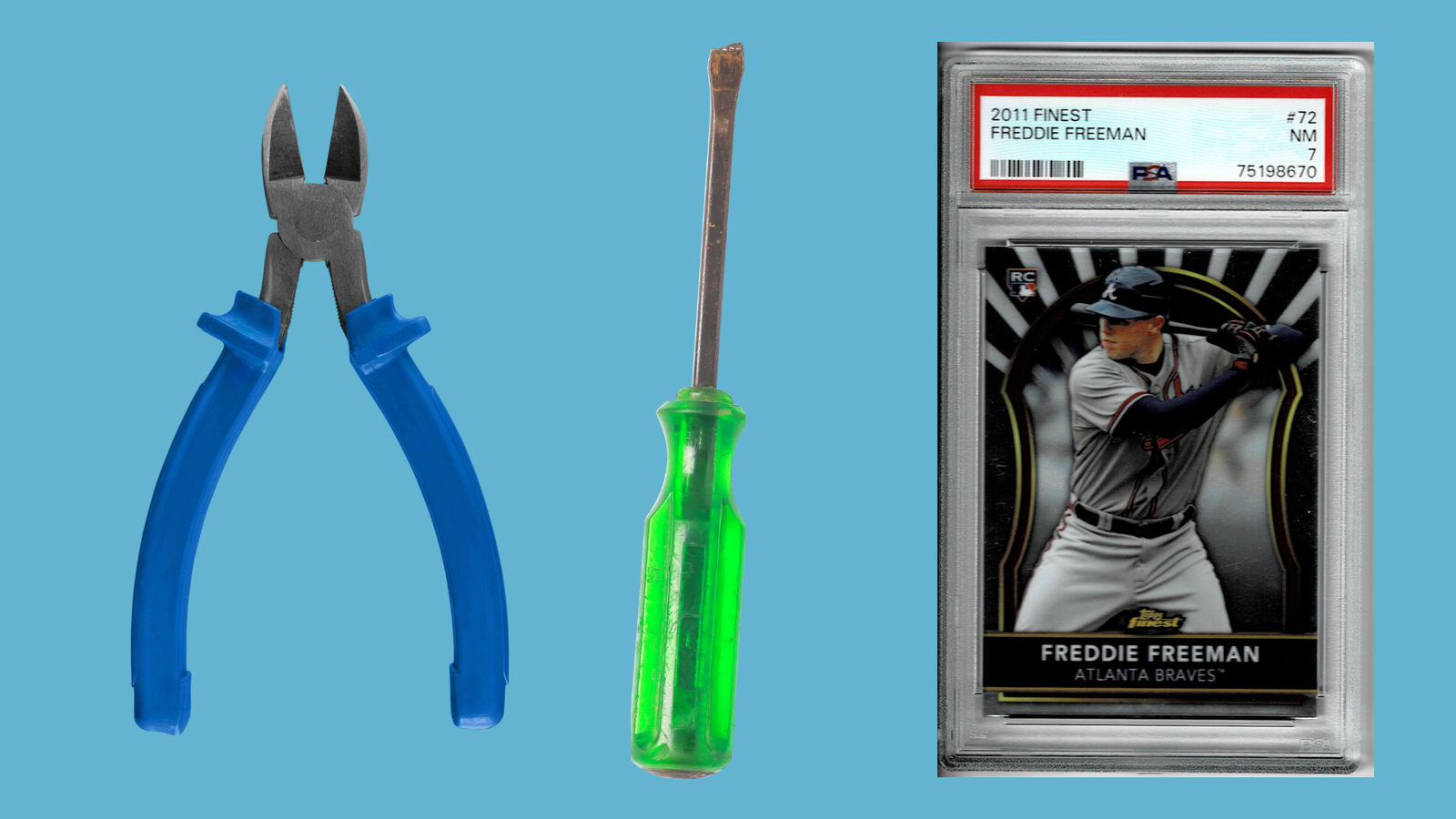So you want to know how to crack a graded card slab? Well, that’s why you are here right? Graded cards hold significant value in the world of card collecting. They not only showcase a card’s worth but also protect it within a plastic slab. Once graded and sealed, these slabs are meant to be tamper-proof to preserve the credibility of the grading process. However, some collectors choose to crack open these slabs, usually to have the card re-graded for a potentially higher grade or to switch grading companies.
Despite the costs and lengthy process of grading cards, there are instances where cracking open a slab can be beneficial. This article guides you on safely breaking PSA, BGS, SGC, and other graded card slabs without damaging the valuable contents inside.
Key Takeaways
- Cracking graded card slabs is often done to pursue re-grading for higher value or change grading companies.
- Ensure you have the right tools and follow a step-by-step process to safely crack open a slab.
- Protect the card during and after the process to avoid damaging its quality and potential value.
Can You Crack PSA, BGS, And SGC Slabs?
As an avid collector and enthusiast in the world of trading cards, I’ve often been asked whether it’s possible to safely crack open slabs from top grading companies like PSA, BGS, and SGC. Through my experience, I can confidently say that it is indeed possible to do so without causing any harm to the precious card inside. This process, though, requires a steady hand and the right tools to ensure that the card remains pristine.
I’ve come to understand that there are several reasons why someone might want to free their card from its slab. Perhaps they’re looking to resubmit the card for grading in hopes of a higher score, or maybe they’re wanting to transfer it to a different grading company for a second opinion. In some cases, collectors simply prefer to have their cards in a more accessible form for personal enjoyment.
The key to successfully cracking open these slabs lies in patience and precision. I start by carefully inspecting the slab to identify the best point of entry. Usually, this is along the edges where the two halves of the slab meet. Using a specialized tool, such as a slab cutter or a small screwdriver, I gently work my way around the edge, applying minimal force to gradually separate the halves.
One thing to keep in mind is the inherent risk involved in this process. While I’ve had success in safely extracting cards, there’s always a slight chance of damaging the card, especially if the right tools aren’t used or if the process is rushed. That’s why I always take my time and work in a well-lit, clean space to minimize any potential mishaps.
After successfully freeing the card, the next step is usually to have it re-encased. Sending the card back to a grading company for a fresh slab is crucial for maintaining its protection and value. This step is particularly important if you’re planning to sell or trade the card in the future, as a graded card in a secure slab is often more appealing to potential buyers or traders.
Cracking open PSA, BGS, and SGC slabs is a feasible task for those who wish to do so. However, it’s a task that should be approached with caution and respect for the card’s condition. As a collector myself, I understand the value and sentiment attached to these cards, and I always recommend weighing the risks before proceeding with such a delicate operation.
Tools Required To Crack A Graded Card Slab
To safely crack open a graded card slab, you’ll need two essential tools:
- Pliers: A regular-sized pair (example).
- Flathead screwdriver: Thinner and smaller versions are preferable (example).
Additionally, have a card sleeve and top loader ready for immediate card protection once it’s removed from the slab.
How To Safely Crack A Graded Card Slab – Step By Step Guide
Step 1
I start by holding the bottom half of the slab firmly in one hand and using pliers to crack the plastic at the top of the slab in one of the corners. It is crucial to crack the plastic above the label to avoid potential contact with the card inside. Firmly gripping the top corner with the pliers and twisting or snapping should create an incision in the plastic.
Step 2
After creating an opening in the plastic at the top of the slab, I have enough room to slide a flathead screwdriver between the two sides of the plastic slab. The best approach is to insert the screwdriver through one of the corners, sliding it sideways along the label rather than down toward the card. By applying pressure upwards or twisting the screwdriver, I separate the top and bottom pieces of plastic. Some slabs, like PSA cases, may require more pressure.
Step 3
Once the flathead screwdriver has loosened the hold between the top and bottom pieces of the slab and I hear a slight cracking sound as they separate, I can do the rest with my hands. Holding the top piece of the slab in one hand and the bottom piece in the other, I carefully pull them apart without snapping or cracking the plastic inwards, which could damage the card.
Step 4
After separating and pulling apart the casing, I gain access to the card inside. Gently, I pick up the card and place it into a card sleeve and top loader to keep it protected from bending or scratching.
Why Do People Crack Open Graded Card Slabs?
As a collector myself, I’ve noticed that people crack open graded card slabs primarily to have the card inside regraded. This can occur for several reasons:
- Borderline condition: Collectors might believe the card’s current grade is too low, and it could achieve a higher grade if resubmitted.
- Regrading preference: Some collectors prefer to submit their cards to specific grading services (e.g., PSA or Beckett), believing it adds more value or aligns better with their collection.
- Bias towards initial grade: When resubmitting a slabbed card for regrading, collectors worry the grading companies will maintain the initial grade due to potential bias. By submitting the card as raw, they hope to remove that bias.
When cracking open a slab, it’s essential to be cautious since it can be a risky and expensive endeavor. Cards with low grades, centering issues, creases, or other faults may not benefit from regrading, and damaging the card in the process can further decrease its value. On the other hand, the potential increase in value after regrading might make cracking a slab worthwhile, particularly for high-grade raw cards. As someone with experience in the field, it’s important to weigh the potential risks and benefits carefully before deciding to crack open a graded card slab.

Hi there! I’m Felix Gonzalez and I am the owner of Card Collecting Insider, and I’m thrilled to welcome you to my site! With our tagline “Uncover the Art of Collecting, One Card at a Time,” I’m here to provide you with expert insights, valuable resources, and the latest trends in the world of card collecting. Whether you’re a seasoned collector or just starting out, I’m dedicated to helping you discover hidden gems and sharing insider tips to elevate your collection. So join me on this exciting journey, as I dive deep into the captivating realm of card collecting. Let’s unlock the true beauty of these collectible treasures together!

